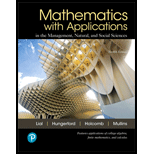
Concept explainers
a)
To calculate: The average rate of change of sales with respect to number of catalogues distributed for given change in
b)
To calculate:
The average rate of change of sales with respect to number of catalogues distributed for given change in
c)
To calculate: The average rate of change of sales with respect to number of catalogues distributed for given change in
d) What is happening to the average rate of change of sales as the number of catalogs distributed increases?
The nature of average rate of change of sales with increase in the no. of distribution of catalogues.
e) Explain why what you have found in part (d) might happen.
The reason for decrease in the average rate of change of sales.
Want to see the full answer?
Check out a sample textbook solution
Chapter 11 Solutions
Mathematics with Applications In the Management, Natural, and Social Sciences (12th Edition)
- EXAMPLE 6.2 In Example 5.4, we considered the random variables Y₁ (the proportional amount of gasoline stocked at the beginning of a week) and Y2 (the proportional amount of gasoline sold during the week). The joint density function of Y₁ and Y2 is given by 3y1, 0 ≤ y2 yı≤ 1, f(y1, y2) = 0, elsewhere. Find the probability density function for U = Y₁ - Y₂, the proportional amount of gasoline remaining at the end of the week. Use the density function of U to find E(U).arrow_forward7.20 a If U has a x² distribution with v df, find E(U) and V (U). b Using the results of Theorem 7.3, find E(S2) and V (S2) when Y₁, Y2,..., Y, is a random sample from a normal distribution with mean μ and variance o².arrow_forwardAccording to a survey conducted by the American Bar Association, 1 in every 410 Americans is a lawyer, but 1 in every 64 residents of Washington, D.C., is a lawyer. a If you select a random sample of 1500 Americans, what is the approximate probability that the sample contains at least one lawyer? b If the sample is selected from among the residents of Washington, D.C., what is the ap- proximate probability that the sample contains more than 30 lawyers? c If you stand on a Washington, D.C., street corner and interview the first 1000 persons who walked by and 30 say that they are lawyers, does this suggest that the density of lawyers passing the corner exceeds the density within the city? Explain.arrow_forward
- 7.50 Shear strength measurements for spot welds have been found to have standard deviation 10 pounds per square inch (psi). If 100 test welds are to be measured, what is the approximate probability that the sample mean will be within 1 psi of the true population mean? 7.51 Refer to Exercise 7.50. If the standard deviation of shear strength measurements for spot welds is 10 psi, how many test welds should be sampled if we want the sample mean to be within 1 psi of the true mean with probability approximately 992arrow_forward8.12 The reading on a voltage meter connected to a test circuit is uniformly distributed over the interval (0, +1), where 0 is the true but unknown voltage of the circuit. Suppose that Y₁, Y2,..., Y, denote a random sample of such readings. a Show that Y is a biased estimator of and compute the bias. b Find a function of Y that is an unbiased estimator of 0. C Find MSE(Y) when Y is used as an estimator of 0.arrow_forwardx 1.1 1.2 1.3 f 3.1 3.9 य find numerical f'(1) by using approximation.arrow_forward
- No chatgpt pls will upvote Already got wrong chatgpt answer Plz no chatgpt downvote.arrow_forwardQ/Let G be a simple graph-show that if Gis not connected, then it is complement is Connected.arrow_forwardQ/prove that if d (u,v) >2 then there is a vertex z in G st. d (u,v) = d(u, z)+d(z₁v)arrow_forward
- T Figure E Statement 33 33° H 40 R 37° 83° S T 55 45 K S 30 U 44 87 H 56 36 ° 54 F 83° 66 P 33 87° ° I 42 200 Rarrow_forwardQui find the diameter & radius for a graph PG.arrow_forwardQ7. Prove that " there is no simple graph on four vertices, three of which have degree 3 and the remaining vertex has degree 1". (10M)arrow_forward
 Discrete Mathematics and Its Applications ( 8th I...MathISBN:9781259676512Author:Kenneth H RosenPublisher:McGraw-Hill Education
Discrete Mathematics and Its Applications ( 8th I...MathISBN:9781259676512Author:Kenneth H RosenPublisher:McGraw-Hill Education Mathematics for Elementary Teachers with Activiti...MathISBN:9780134392790Author:Beckmann, SybillaPublisher:PEARSON
Mathematics for Elementary Teachers with Activiti...MathISBN:9780134392790Author:Beckmann, SybillaPublisher:PEARSON
 Thinking Mathematically (7th Edition)MathISBN:9780134683713Author:Robert F. BlitzerPublisher:PEARSON
Thinking Mathematically (7th Edition)MathISBN:9780134683713Author:Robert F. BlitzerPublisher:PEARSON Discrete Mathematics With ApplicationsMathISBN:9781337694193Author:EPP, Susanna S.Publisher:Cengage Learning,
Discrete Mathematics With ApplicationsMathISBN:9781337694193Author:EPP, Susanna S.Publisher:Cengage Learning, Pathways To Math Literacy (looseleaf)MathISBN:9781259985607Author:David Sobecki Professor, Brian A. MercerPublisher:McGraw-Hill Education
Pathways To Math Literacy (looseleaf)MathISBN:9781259985607Author:David Sobecki Professor, Brian A. MercerPublisher:McGraw-Hill Education





